
The tornado outbreak of April 6–9, 1998 was a large tornado outbreak that started on April 6 across the Great Plains and ended on April 9 across the Carolinas and Georgia. A total of 62 tornadoes touched down from the Middle Atlantic States to the Midwestern United States and Texas. The outbreak is infamous for producing a deadly F5 that tore through the suburbs of Birmingham, Alabama, killing 32 people. The Birmingham tornado was one of only two F5 tornadoes that year. The other hit in Lawrence County, Tennessee, on April 16, as part of the same outbreak as the Nashville F3 tornado. This tornado outbreak was responsible for 41 deaths: 7 in Georgia and 34 in Alabama.
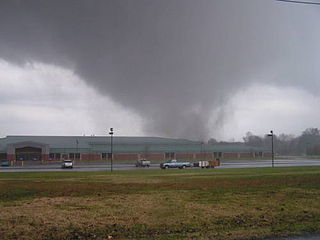
This page documents notable tornadoes and tornado outbreaks worldwide in 2005. Strong and destructive tornadoes form most frequently in the United States, Bangladesh, Argentina, Brazil and Eastern India, but they can occur almost anywhere under the right conditions. Tornadoes also develop occasionally in southern Canada during the Northern Hemisphere's summer and somewhat regularly at other times of the year across Europe, Asia, and Australia. Tornadic events are often accompanied with other forms of severe weather, including strong thunderstorms, strong winds, and hail.

This page documents notable tornadoes and tornado outbreaks worldwide in 2004. Strong and destructive tornadoes form most frequently in the United States, Bangladesh, and Eastern India, but they can occur almost anywhere under the right conditions. Tornadoes also develop occasionally in southern Canada during the Northern Hemisphere's summer and somewhat regularly at other times of the year across Europe, Asia, and Australia. Tornadic events are often accompanied with other forms of severe weather, including strong thunderstorms, strong winds, and hail.
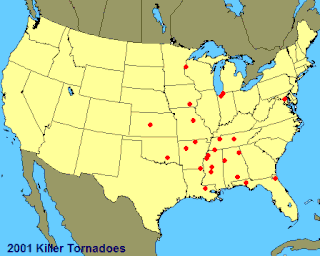
This page documents notable tornadoes and tornado outbreaks worldwide in 2001. Strong and destructive tornadoes form most frequently in the United States, Bangladesh, and Eastern India, but they can occur almost anywhere under the right conditions. Tornadoes also develop occasionally in southern Canada during the Northern Hemisphere's summer and somewhat regularly at other times of the year across Europe, Asia, and Australia. Tornadic events are often accompanied with other forms of severe weather, including strong thunderstorms, strong winds, and hail.
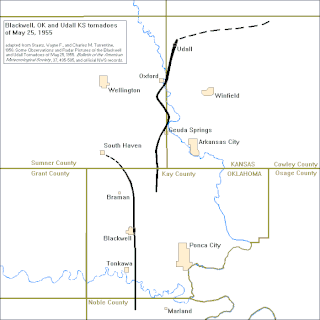
The 1955 Great Plains tornado outbreak was a deadly tornado outbreak that struck the southern and central U.S Great Plains States on May 25–26, 1955. It produced at least 47 tornadoes across seven states including two F5 tornadoes in Blackwell, Oklahoma, and Udall, Kansas that caused most of the casualties. The outbreak killed 102 people while injuring hundreds more. Unusual electromagnetic activity was observed, including St. Elmo's fire.
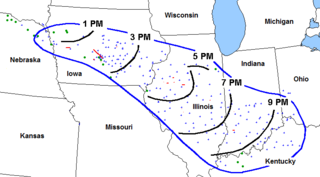
The Corn Belt derecho was a progressive derecho which affected a large area of the central United States on June 29, 1998. In the morning, thunderstorms, including a supercell, developed over South Dakota and tracked into central Iowa. As the thunderstorms reached central Iowa, a strong rear-inflow jet developed which caused the thunderstorm to take on a different characteristic, becoming a derecho. It traveled more than 600 miles in about ten hours, causing more than $125 million worth of widespread damage destruction, especially to crops, and was responsible for power outages to nearly a half a million people.

This page documents the tornadoes and tornado outbreaks of 1996, primarily in the United States. Most tornadoes form in the U.S., although some events may take place internationally. Tornado statistics for older years like this often appear significantly lower than modern years due to fewer reports or confirmed tornadoes, however by the 1990s tornado statistics were coming closer to the numbers we see today.
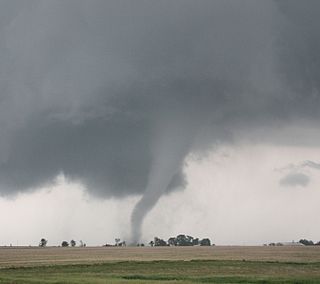
The tornado outbreak of June 5–6, 2010, was a tornado outbreak that affected the Midwestern United States and Great Lakes region, starting the weekend of June 5, 2010, and extending into the morning of June 6, 2010. At least 53 tornadoes were confirmed from Iowa to southern Ontario and Ohio as well as in northern New England. Seven people were confirmed dead in Ohio just outside Toledo, and one in Dwight, Illinois. Damage from the tornadoes in the United States totaled over $266 million.

The 2011 Super Outbreak was the largest, costliest, and one of the deadliest tornado outbreaks ever recorded, taking place in the Southern, Midwestern, and Northeastern United States from April 25 to 28, 2011, leaving catastrophic destruction in its wake. Over 175 tornadoes struck Alabama, Mississippi, and Tennessee, which were the most severely damaged states. Other destructive tornadoes occurred in Arkansas, Georgia, Kentucky, Louisiana, New York, and Virginia, with storms also affecting other states in the Southern and Eastern United States. In total, 360 tornadoes were confirmed by NOAA's National Weather Service (NWS) and Government of Canada's Environment Canada in 21 states from Texas to New York to southern Canada. Widespread and destructive tornadoes occurred on each day of the outbreak. April 27 was the most active day, with a record 216 tornadoes touching down that day from midnight to midnight CDT. Four of the tornadoes were rated EF5, which is the highest ranking on the Enhanced Fujita scale; typically these tornadoes are recorded no more than once a year.
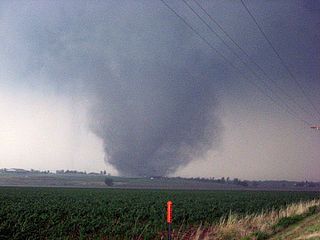
From May 21 to May 26, 2011, one of the largest tornado outbreaks on record affected the Midwestern and Southern regions of the United States. A six-day tornado outbreak sequence, most of the tornadoes developed in a corridor from Lake Superior southwest to central Texas, while isolated tornadoes occurred in other areas. An especially destructive EF5 tornado destroyed one-third of Joplin, Missouri, resulting in 158 deaths and over 1,000 injuries. The Joplin tornado was the deadliest in the United States since April 9, 1947, when an intense tornado killed 181 in the Woodward, Oklahoma, area. Tornado-related deaths also occurred in Arkansas, Kansas, Minnesota, and Oklahoma. Overall, the tornado outbreak resulted in 186 deaths, 8 of those non-tornadic, making it second only to the 2011 Super Outbreak as the deadliest since 1974. It was the second costliest tornado outbreak in United States history behind that same April 2011 outbreak, with insured damage estimated at $4–7 billion.
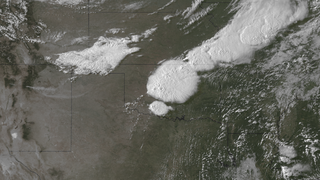
A prolonged and widespread tornado outbreak sequence affected a large portion of the United States in late-May 2013 and early-June 2013. The outbreak was the result of a slow-moving but powerful storm system that produced several strong tornadoes across the Great Plains states, especially in Kansas and Oklahoma. Other strong tornadoes caused severe damage in Nebraska, Missouri, Illinois, and Michigan. The outbreak extended as far east as Upstate New York. 27 fatalities were reported in total, with nine resulting from tornadoes.

This page documents notable tornadoes and tornado outbreaks worldwide in 2017. Strong and destructive tornadoes form most frequently in the United States, Brazil, Bangladesh, and Eastern India, but they can occur almost anywhere under the right conditions. Tornadoes also develop occasionally in southern Canada during the Northern Hemisphere's summer and somewhat regularly at other times of the year across Europe, Asia, Argentina and Australia. Tornadic events are often accompanied with other forms of severe weather, including strong thunderstorms, strong winds, and hail.

The tornado outbreak sequence of May 2019 was a prolonged series of destructive tornadoes and tornado outbreaks affecting the United States over the course of nearly two weeks, producing a total of 402 tornadoes, including 53 significant events (EF2+). Eighteen of these were EF3 tornadoes, spanning over multiple states, including Nebraska, Kansas, Texas, Missouri, Oklahoma, Indiana, Iowa, and Ohio, with additional tornadoes confirmed across a region extending from California to New Jersey. Two EF4 tornadoes occurred, one in Dayton, Ohio, and the other in Linwood, Kansas. Four tornadoes during this outbreak were fatal, causing a total of eight fatalities. The deadliest of these occurred on May 22 near Golden City, Missouri, where an EF3 tornado took three lives, including an elderly couple in their eighties. The damaging series of tornadoes that occurred in Indiana and Ohio on the evening of May 27 during this event is sometimes locally referred to as the Memorial Day tornado outbreak of 2019, which became the fourth costliest weather event in Ohio history. The near continuous stream of systems also produced to widespread flash and river flooding, along with damaging winds and large hail.

This page documents notable tornadoes and tornado outbreaks worldwide in 2020. Strong and destructive tornadoes form most frequently in the United States, Argentina, Brazil, Bangladesh, and eastern India, but can occur almost anywhere under the right conditions. Tornadoes also develop occasionally in southern Canada during the Northern Hemisphere's summer and somewhat regularly at other times of the year across Europe, Asia, Argentina, Australia and New Zealand. Tornadic events are often accompanied by other forms of severe weather, including strong thunderstorms, strong winds, and hail.

A widespread and deadly tornado outbreak affected the Southeastern United States on Easter Sunday and Monday, April 12–13, 2020. Several tornadoes were responsible for prompting tornado emergencies, including the first one to be issued by the National Weather Service in Charleston, South Carolina. A large squall line formed and tracked through the mid-Atlantic on April 13, prompting more tornado warnings and watches. A total of 15 watches were produced during the course of the event, two of which were designated Particularly Dangerous Situations.
This page documents the tornadoes and tornado outbreaks of 1951, primarily in the United States. Most tornadoes form in the U.S., although some events may take place internationally. Tornado statistics for older years like this often appear significantly lower than modern years due to fewer reports or confirmed tornadoes.

This page documents notable tornadoes and tornado outbreaks worldwide in 2021. Strong and destructive tornadoes form most frequently in the United States, Argentina, Brazil, Bangladesh, and Eastern India, but can occur almost anywhere under the right conditions. Tornadoes also develop occasionally in southern Canada during the Northern Hemisphere's summer and somewhat regularly at other times of the year across Europe, Asia, Argentina, Australia and New Zealand. Tornadic events are often accompanied by other forms of severe weather, including strong thunderstorms, strong winds, and hail.

A deadly late-season tornado outbreak, the deadliest on record in December, produced catastrophic damage and numerous fatalities across portions of the Southern United States and Ohio Valley from the evening of December 10 to the early morning of December 11, 2021. The event developed as a trough progressed eastward across the United States, interacting with an unseasonably moist and unstable environment across the Mississippi Valley. Tornado activity began in northeastern Arkansas, before progressing into Missouri, Illinois, Tennessee, and Kentucky.

A significant early spring tornado outbreak occurred throughout the Midwestern and Northeastern United States, mainly within Illinois, Indiana, and Ohio. More than two dozen tornadoes occurred, eight of them strong-to-intense. National Weather Service offices issued multiple 'Particularly Dangerous Situation' tornado warnings. Tornadoes produced heavy damage in the communities of Madison, Winchester and Muncie in Indiana, and Wapakoneta, Lakeview, and Plymouth in Ohio. At least three people were killed in Logan County, Ohio in the Lakeview tornado, and dozens of others were left injured or missing.


















